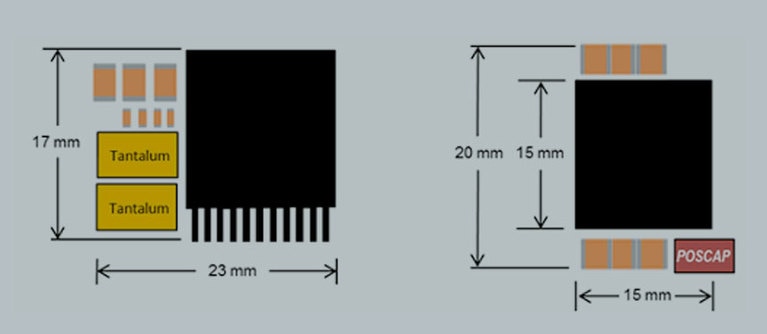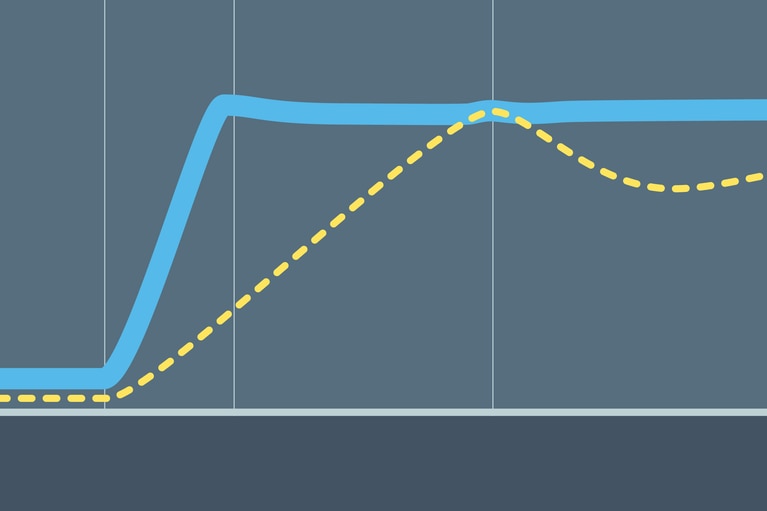
ReVolt – 技术问答
ReVolt 正在解决好莱坞片场的排放问题,下一步将把便携式 DC 电源应用于建筑工地、应急响应事件等领域
尊敬的用户:
为了改进 Vicor 网站,我们将于美国东部时间 12 月 29 日上午 11:30 至下午 2:00 对网站进行维护。
在此期间,您可能无法查看网站的某些部分,特别是产品页面和产品型号列表。
对于给您带来的不便,我们深表歉意,并感谢您的耐心等待。
– Vicor 网站团队
The key questions to consider are: How much space do I have on my board? What features do I need? How important is efficiency in my design? When you have established the answers to these questions, you are in a better position to understand what you need to look for when selecting a buck regulator; which elements are essential and which fall into the category “nice to have.”
I apologize if it seems obvious, but it is important to look not just at the package size. So, for example, the graphics below, show two modules available today from two suppliers. The package itself seems quite small, but once you account for the auxiliary devices, primarily capacitors, the overall size of what we call the buck regulation application, increases.
The other thing that can cause the overall solution size to increase is any layout dependency in the design. Specific routing requirements of either analog ground or power output, etc., can increase the size of the design greatly from the package alone.
As I mentioned already, with high power density there are thermal considerations. When you make something smaller, of course, it is more of a challenge to dissipate the heat. Derating is key in looking at what regulator you truly need.
Another consideration is power output. It is not just the size of the one regulator: can you reduce the number of regulators on a board? For example, if you can replace two regulators with just one, that would be a dramatic reduction of space used on the board, improving the density of your solution.
Higher frequency operation is very desirable with regards density. Typically, there is not much of a choice, or you are limited to a frequency range in which the buck regulator operates. However, a buck regulator that operates at a higher frequency will be smaller , and the size of the passives can be reduced. A negative feature of higher frequency operation, though, is switching losses. As you go higher in frequency, you lose on efficiency. This is one of the things we counter in our products through the use of the ZVS topology, but in conventional buck regulators, this is a trade-off that may have to be made.
Some of the more basic features found in today’s buck regulators are soft-start, or tracking.. Soft start allows you to control the ramp up of the output to achieve the final voltage. A similar function is to have the multiple outputs track each other, either one-to-one or in a ratio.If you are powering a microprocessor, you may require the core to come up first before the peripherals, etc. Soft-start and/or tracking are critical to ensure smooth power-up.
Another feature is pre-bias load start-up; this is how well a buck regulator can start up into a rail or power that is already present on the line. Does it pull that line down, or is it able to continue to power from the existing voltage that is on the line to the desired voltage? Pre-biased load start-up ensures that the rail holds at the required voltage when a regulator starts up.
I think efficiency is pretty obvious to people; it is the conversion of the input to the output. What is critical is keeping in mind the efficiency across the operating conditions of the application. Typically, you have efficiency at operating current, that is at a high-load current, and then you also have efficiency when you are in a standby or straight mode; what we call light, or low, load and high load. These two numbers are critical. The light load that is, say, sub one amp is critical for meeting standby requirements. Of course, the high load gives overall efficiency while in full operation.
While device efficiency is the measurement of the output to the input, any calculation of system efficiency needs to take into account line losses. Line losses can play a very important role, when looking at overall efficiency. Part of the whole concept of Point-of-Load conversion is the idea to reduce the line losses by placing regulation near the point of load. This can be done by routing a higher voltage closer to the point of load and then regulating down to a lower voltage. By bearing these performance criteria in mind, you can design an efficient, effective buck regulator to suit your application size and needs.
In the next part of the interview, we will look at some of the ways buck regulators can be implemented and then we will consider the role of Zero Voltage Switching (ZVS) architecture.
Related content
ReVolt – 技术问答
ReVolt 正在解决好莱坞片场的排放问题,下一步将把便携式 DC 电源应用于建筑工地、应急响应事件等领域
双向供电与快速瞬态响应能力赋能可扩展的主动悬架系统
正弦振幅转换器™(SAC™)模块凭借其独特的双向供电功能与瞬态响应速度组合,为主动悬架系统开辟了全新可能性
提供更高的峰值功率和更快的动态瞬态响应,实现更轻、更强大的电动汽车架构
随着时间的推移,市场上的电动汽车 (EV) 对电驱动系统的依赖程度日益加深,例如线控转向、线控制动以及主动悬架系统等
电流倍增器:为 AI 处理器及其他严苛应用供电的明智之选
AI 处理器需要解决低电压、高电流的严苛挑战,这将会导致电源系统设计产生瓶颈。了解 Vicor 的电流倍增技术如何改变这一现状



